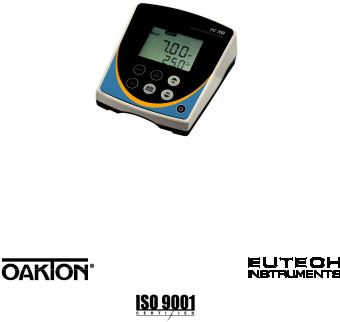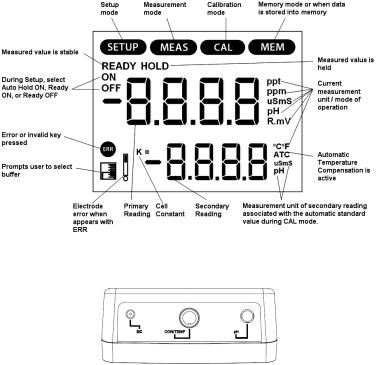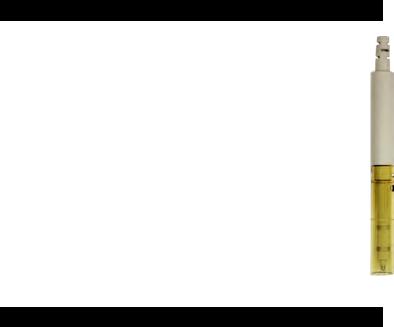Eutech instruments PC 700 Manual

Instruction Manual
PC 700 pH/mV/Conductivity/ºC/ºF
Bench Meter
Technology Made Easy ...
Part of Thermo Fisher Scientific |
68X541704 Rev 2 Sep. 2010 |
|
TABLE OF CONTENTS |
|
1. |
INTRODUCTION .............................................................. |
1 |
2. |
GETTING STARTED........................................................ |
2 |
2.1 |
Keypad Functions ................................................................... |
2 |
2.2 |
LCD Annunciators................................................................... |
3 |
2.3 |
Meter Connections .................................................................. |
3 |
3. |
CONDUCTIVITY ELECTRODE ....................................... |
4 |
4. PH AND MV CALIBRATION............................................ |
4 |
|
4.1 |
pH Calibration ......................................................................... |
4 |
4.2 |
Millivolt (mV) Offset Adjustment .............................................. |
6 |
5. CONDUCTIVITY AND TDS CALIBRATION.................... |
6 |
|
5.1 |
Automatic or Manual Calibration ............................................. |
6 |
5.2 |
Single or Multi-Point Calibration.............................................. |
7 |
5.3 |
General Calibration Tips ......................................................... |
8 |
5.4 |
Automatic Conductivity Calibration Procedure ........................ |
8 |
5.5 |
Manual Conductivity & TDS Calibration Procedure................. |
9 |
5.6 |
Temperature Calibration ......................................................... |
9 |
6. CONDUCTIVITY AND TDS MEASUREMENT ................ |
10 |
|
6.1 |
Taking Measurements............................................................. |
10 |
6.2 |
Automatic and Manual Ranging .............................................. |
10 |
7. |
HOLD FUNCTION............................................................ |
11 |
8. STORING AND RECALLING DATA ............................... |
11 |
|
9. |
SETUP FUNCTIONS........................................................ |
12 |
9.1 |
1.0 CAL (Calibration)............................................................... |
12 |
9.2 |
2.0 ELE (Electrode Information).............................................. |
12 |
9.3 |
3.0 ConF (Configuration)......................................................... |
13 |
9.4 |
3.1 rdY (Ready / Stability Indicator)......................................... |
13 |
9.5 |
3.2 ºC ºF (Celsius or Fahrenheit) ............................................ |
13 |
9.6 |
3.3 buFF (pH Buffers & Calibration Points)—pH only ............. |
13 |
9.7 |
|
3.3 |
AtC (Auto Temp Compensation)—Con & TDS only .......... |
13 |
9.8 |
|
3.4 tdS (TDS factor)—Con & TDS only ................................... |
14 |
|
9.9 |
|
3.5 t.CO (Temperature Coefficient)—Con & TDS only............ |
14 |
|
9.10 |
3.6 t.nr (Normalization Temperature in ºC)—Con & TDS only 14 |
|||
9.11 |
3.7 |
ACAL (Auto Conductivity Calibration)—Con & TDS only .. |
15 |
|
9.12 |
3.8 |
SPC (Single Point Calibration)—Con & TDS only............. |
15 |
|
9.13 |
3.9 |
CELL (Nominal Cell Constant)—Con & TDS only............. |
15 |
|
9.14 |
4.0 rSt (Reset)......................................................................... |
16 |
||
9.15 |
5.0 |
CLr (Clear Memory) .......................................................... |
16 |
|
10. |
CALCULATING TDS CONVERSION FACTOR .............. |
17 |
||
11. |
CALCULATING TEMPERATURE COEFFICIENTS........ |
18 |
||
12. |
REPLACEMENTS AND ACCESSORIES........................ |
19 |
||
13. |
TROUBLESHOOTING GUIDE......................................... |
20 |
||
14. |
SPECIFICATIONS............................................................ |
22 |
||
15. |
WARRANTY..................................................................... |
24 |
||
16. |
RETURN OF ITEMS......................................................... |
25 |
||

1. INTRODUCTION
Thank you for purchasing our PC 700 series benchtop meter. This microprocessor-based meter is economical and simple to use. The design incorporates a large LCD for clear viewing, yet offers a small footprint to conserve space.
The PC 700 measures pH, mV (ORP), conductivity, or TDS simultaneously with temperature (ºC or ºF).
Each meter includes a convenient slide-out card for quick reference. Also included is an electrode arm and metal bracket which can be easily attached to the left or right side of the meter according to your preference.
The PC 700 benchtop meter replaces our popular pH/CON 510 series meter that was introduced in 2000.
We take great pride in every instrument we manufacture and hope this one serves you well.
1

2. GETTING STARTED
2.1 Keypad Functions
Powers the meter on and off. Upon power on, the meter automatically begins in the mode that was last used. Calibration and memory values are retained even if meter is unplugged.
Toggle between available measurement modes— pH/Temp, mV/Temp, Conductivity/Temp, or TDS/Temp. Also used to switch to Temperature calibration during pH, mV, Conductivity or TDS calibration modes.
Press and hold for 5 seconds to enter SETUP mode.
Toggles between measurement and calibration modes. In SETUP mode, returns user to the measurement mode.
Confirms calibration values in CAL mode. Confirms selections in SETUP mode.
Changes Con/TDS range and resolution in MEAS mode. View recalled values in memory mode.
MI (Memory Insert) stores values into memory.
S Increase value. Scroll up in SETUP & CAL modes.
MR (Memory Recall) recalls values from memory
T Decrease value. Scroll down in SETUP & CAL modes.
Freezes measured reading. Press again to resume live reading.
2

2.2 LCD Annunciators
2.3 Meter Connections
DC |
Power supply |
|
|
|
|
CON/ |
8-pin DIN connection for 2-cell Con/TDS/Temp electrode |
|
TEMP |
||
|
||
|
|
|
pH |
BNC connection for pH, or ORP (Redox) electrode |
|
|
|
|
|
|
|
|
3 |

3. CONDUCTIVITY ELECTRODE
The PC 700 includes an electrode with a nominal cell constant of k = 1.0, built-in temperature sensor, and 1 meter cable. The Ultem body housing has good chemical resistant properties. The electrode design offers fast temperature response and reduces air entrapment, ensuring accurate, repeatable, and stable readings.
The wetted materials of the probe include:
•Polyetherimide (Ultem) – protective probe guard
•Polybutylterphalate (Valox) – sensor housing
•Stainless Steel (SS 304) – 2 bands
The protective probe guard can be removed temporarily for cleaning however it must be re-attached during measurement and calibration. Erroneous results will occur while the probe guard is removed.
Always immerse the probe beyond upper steel band for best results. Use the fill line on the outside of the probe guard for reference.
4. PH AND MV CALIBRATION
4.1 pH Calibration
For best results, periodic calibration with known accurate standards is recommended. Calibrate with standards that bracket your intended measuring range while including a neutral standard (pH 7.00 or 6.86). For example, if you expect to measure samples from pH 6.2 to pH 9.5, calibration with 4.01, 7.00, and 10.01 will work well.
The PC 700 meter can be calibrated with up to 5 buffers. The non-volatile memory retains all calibration values upon meter shut down.
4
The following calibration standards are automatically recognized;
USA buffer group |
1.68, 4.01, 7.00, 10.01, 12.45 |
NIST buffer group |
1.68, 4.01, 6.86, 9.18, 12.45 |
|
|
See Section 9.6 to change the buffer group
1)Press  as needed to select pH.
as needed to select pH.
2)Dip the pH and ATC electrodes into pH buffer and press  . The secondary display will lock on the appropriate buffer value. Provide stirring for best results. When the READY indicator appears, press
. The secondary display will lock on the appropriate buffer value. Provide stirring for best results. When the READY indicator appears, press  to accept. The primary reading will flash briefly before the secondary display begins scrolling the remaining available buffers.
to accept. The primary reading will flash briefly before the secondary display begins scrolling the remaining available buffers.
3)Rinse the pH and ATC electrodes then dip into the next pH buffer. The secondary display will lock on the appropriate buffer value. When the READY indicator appears, press  to accept. The primary reading will flash briefly then display the percent efficiency (slope) before the secondary display begins scrolling the remaining available buffers.
to accept. The primary reading will flash briefly then display the percent efficiency (slope) before the secondary display begins scrolling the remaining available buffers.
4)To calibrate another buffer repeat step 3) or press  to return to the measurement mode. Note: The meter will automatically return to measurement mode upon successful completion of the number of specified calibration points. To specify a different number of pH calibration points see Section 9.6.
to return to the measurement mode. Note: The meter will automatically return to measurement mode upon successful completion of the number of specified calibration points. To specify a different number of pH calibration points see Section 9.6.
TIPS: A single point (offset) calibration is only allowed with pH 7.00 or pH 6.86 buffers.
When the first calibration value is accepted during a new calibration, all prior calibration values are erased.
Press  at any time to abort calibration and return to measurement mode.
at any time to abort calibration and return to measurement mode.
5

4.2 Millivolt (mV) Offset Adjustment
Oxidization Reduction Potential (ORP or Redox) is not a precise measurement, but is useful as a relative indicator. As such, mV offset adjustment is not meant to enhance accuracy, but rather to make readings comparable to a reference. Commercial ORP solutions are often used as a check standard in which a meter/electrode system are verified to be close to a given value, instead of being used as a calibration standard in which adjustments are made in an attempt to match the ORP value.
1)Connect an ORP electrode and press  as needed to select mV (or R.mV).
as needed to select mV (or R.mV).
2)Dip the ORP electrode into a solution with a known mV value (i.e. Zobel, Light’s, quinhydrone, or iodidetriiodide) and stir.
3)Press  when the reading is stable. The primary display shows the relative millivolt value (R.mV) while the secondary display shows the factory default mV value.
when the reading is stable. The primary display shows the relative millivolt value (R.mV) while the secondary display shows the factory default mV value.
4)Adjust the R.mV value using  or
or  . Press
. Press  to accept or
to accept or  to cancel. The meter allows an adjustable maximum value of ± 150 mV from the factory default mV value.
to cancel. The meter allows an adjustable maximum value of ± 150 mV from the factory default mV value.
Note: When an offset has been stored successfully, R.mV replaces mV.
5. CONDUCTIVITY AND TDS CALIBRATION
5.1 Automatic or Manual Calibration
The PC 700 is capable of automatic or manual calibration for conductivity, and manual calibration for TDS.
In the automatic calibration mode, the meter will automatically select one of (4) conductivity calibration standard values depending on the range and normalization temperature being used (TABLE 1).
6
